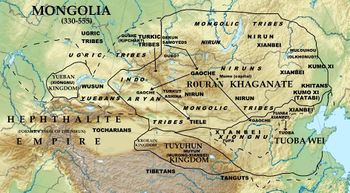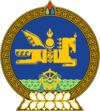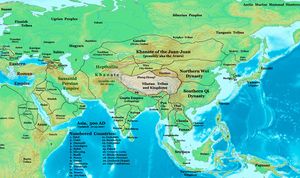خاقانية روران
خاقانية روران | |||||||||||||
|---|---|---|---|---|---|---|---|---|---|---|---|---|---|
| 330 م–555 م | |||||||||||||
 خاقانية روران في وسط آسيا | |||||||||||||
| المكانة | خانية | ||||||||||||
| العاصمة | مدينة مومو، نهر أرخن، منغوليا | ||||||||||||
| اللغات الشائعة | روانروان المنغولية الصينية | ||||||||||||
| الدين | التنگرية الشامانية البوذية | ||||||||||||
| خاقان | |||||||||||||
• 330 م | يوجيولو موگولو | ||||||||||||
• 555 م | يوجيولو دنگشوزي | ||||||||||||
| التشريع | قرلتاي | ||||||||||||
| التاريخ | |||||||||||||
• تأسست | 330 م | ||||||||||||
• انحلت | 555 م | ||||||||||||
| Area | |||||||||||||
| 405[1][2] | 2،800،000 km2 (1،100،000 sq mi) | ||||||||||||
| |||||||||||||
| Today part of | الصين قزخستان منغوليا روسيا | ||||||||||||
| روران | |||||||||||
|---|---|---|---|---|---|---|---|---|---|---|---|
| الصينية | 柔然 | ||||||||||
| |||||||||||
| Ruru | |||||||||||
| الصينية التقليدية | 蠕蠕 | ||||||||||
| الحروف المبسطة | 茹茹 | ||||||||||
| |||||||||||
| Tantan | |||||||||||
| الصينية | 檀檀 | ||||||||||
| |||||||||||
| جزء من سلسلة عن | ||||||||||||||
| تاريخ منغوليا | ||||||||||||||
|---|---|---|---|---|---|---|---|---|---|---|---|---|---|---|
 | ||||||||||||||
| الفترة القديمة | ||||||||||||||
|
||||||||||||||
| العصور الوسطى | ||||||||||||||
|
||||||||||||||
| الفترة المعاصرة | ||||||||||||||
|
||||||||||||||
| موضوعات | ||||||||||||||
خاقانية روران (الصينية: 柔然; پنين: Róurán)؛ Ruanruan (الصينية: 蠕蠕; پنين: Ruǎnruǎn/Rúrú; Wade–Giles: Juan-juan/Ju-ju؛ إنگليزية: Rouran Khaganate)؛ رورو (الصينية: 茹茹; پنين: Rúrú; Wade–Giles: Ju-ju)، أو تانتان Tantan[3] (الصينية: 檀檀; پنين: Tántán) كان اسم دولة غير معروفة الأصل (المنغول الأوائل أو ترك أو غير الألطاي),[4] وبالرغم من شيوع الاعتقاد أن شعبهم انحدر من شيانبـِيْ. ويُذكر عن الروران أنهم أول شعب استخدم لقب "خان" أو "خاقان". استمرت خاقانية روران من أواخر القرن الرابع حتى منتصف القرن السادس، حين هزمهم تمرد الگوقتورك الذي أدى لاحقاً إلى بزوغ الترك في التاريخ العالمي. الروران ربما قد فرّوا إلى الغرب بعد ذلك واصبحوا آڤار پانونيا، إلا أن ذلك هو مجرد نظرية يتجادل حولها المؤرخون. طارد الگوقتورك، بعد ذلك، أولئك "الآڤار" إلى الامبراطورية البيزنطية وأشير إليهم بأنهم "ڤركون Varconites" الذين كانوا عبيداً فارين من الترك. إلا أنهم أيضاً زعموا أن "الآڤار الحقيقيين" هم الذين بقوا في الشرق خاضعين للترك، بينما الآخرين في الغرب كانوا فقط "آڤار كاذبين".
ويُفترض، أحياناً، أن الروران هم نفسهم آڤار پانونيا – المعروفين أيضاً بأسماء مثل ڤركون و "آڤار زائفين" – الذين غزوا أراضي المجر الحالية حوالي القرن السادس.[5]
روران هي نسخ لفظي بالصينية الكلاسيكية للمسمى الداخلي لاتحاد القبائل. إلى أنه، حسب مصادر شيانبـِيْ المستخلصة من أوامر أصدرها الامبراطور تايوو من وِيْ الشمالية، روانروان و رورو تعنيان شيئاً شبيهاً بـ "الدودة المتلوّية" وكانا يُستخدمان بشكل مهين.[6]
التاريخ

الأصل
كان الروران شعبا من البدو الرحل يشيع الاعتقاد أنهم فرع من شيانبـِيْ بقي في شرق السهوب الأوراسية بعد أن هاجر معظم الشيانبـِيْ جنوبا واستقروا في شمال الصين.[7] Kwok Kin Poon proposes that the Rouran were descended specifically from Xianbei of Donghu heritage.[8]
الخاقانية
مؤسس خاقانية روران، Yujiulu Shelun, انحدر من عبيد the Xianbei whose women were commonly taken as wives or concubines. In fact the name Rouran itself as used by the Xianbei means something akin to "wriggling worms". After the Xianbei migrated south and settled in Chinese lands during the late 3rd century AD, the Rouran made a name for themselves as fierce warriors. However they remained politically fragmented until 402 AD when Shelun gained support of all the Rouran chieftains and united the Rouran under one banner. Immediately after uniting, the Rouran entered a perpetual conflict with Northern Wei, beginning with a Wei offensive that drove the Rouran from the Ordos region. توسع الروران غربا وهزموا the neighboring Tiele people and expanded their territory over the Silk Roads, even vassalizing the الهياطل which remained so until the beginning of the 5th century.[9][10] The Hepthalites migrated southeast due to pressure from the Rouran and displaced the Yuezhi in Bactria, forcing the them to migrate further south. بالرغم من النزاع بين الهياطل والروران، فإن الهياطل استعاروا الكثير من سادتهم الشرقيين، وخصوصاً لقب "خان" الذي اِستخدم الروران لأول مرة كلقب لحكامهم.[10]
في 424، غزا الروران Northern Wei إلا أنهم تم صدهم.[11]
In 429, Northern Wei launched a major offensive against the Rouran and killed a large number of people.[9]
The Chinese are foot soldiers and we are horsemen. What can a herd of colts and heifers do against tigers or a pack of wolves? As for the Rouran, they graze in the north during the summer; in autumn, they come south and in winter raid our frontiers. We have only to attack them in summer in their pasture lands. At that time their horses are useless: the stallions are busy with the fillies, and the mares with their foals. If we but come upon them there and cut them off from their grazing and their water, within a few days they will be either taken or destroyed.[9]
In 434, the Rouran entered a marriage alliance with Northern Wei.[12]
In 443, Northern Wei attacked the Rouran.[9]
In 449, the Rouran were defeated in battle by Northern Wei.[13]
In 456, Northern Wei attacked the Rouran.[9]
In 458, Northern Wei attacked the Rouran.[9]
في 460، أخضع الروران قبيلة آشينا المقيمة حول طرفان الحالية وأعادوا توطينهم في جبال ألطاي.[14] The Rouran also ousted the previous dynasty of Gaochang and installed Kan Bozhou as its king.[9]
The Rouran Khaganate arranged for one of their princesses, Khagan Yujiulü Anagui's daughter Princess Ruru, to be married to the Han Chinese ruler Gao Huan of the Eastern Wei.[15]
الانحدار
ساءت العلاقات بين الروران والهياطل وبرزت مشاكل في اتحادهم الكونفدرالي بتشجيع من عملاء صينيين.
وفي 508، هزم التيإلى الروران في معركة.
وفي 516، انتصر الروران على التيإلى.
في 551، بومين من گوقتورك آشينا (الصينية: 突厥) أخمد تمرد التيإلى لصالح روران وطلب مقابل ذلك الحصول على أميرة من الروران لخدمته. الروران رفضوا ورداً على ذلك أعلن بومين الاستقلال.[16] ودخل بومين تحالف زواج مع وِيْ الغربية، a successor state of Northern Wei, and attacked the Rouran in 552, killing Yujiulü Anagui. Bumin declared himself Illig Khagan of the Turkic Khaganate after conquering Otuken; Bumin died soon after and his son Issik Qaghan succeeded him. Issik continued attacking the Rouran but died a year later in 553. His brother Muqan Qaghan finished the job and annihilated the Rouran in 555.[16][17]
الآڤار
Some scholars claim that the Rouran then fled west across the steppes and became the Avars, though many other scholars contest this claim.[4] The remainder of the Rouran fled into China, were absorbed into the border guards, and disappeared forever as an entity. The last khagan fled to the court of the Western Wei, but at the demand of Tujue, Western Wei executed him and the nobles who accompanied him.
اللغة
Alexander Vovin (2004, 2010)[18][19] considers the Ruan-ruan language to be an extinct non-Altaic language that is not related to any modern-day language (i.e., a language isolate) and is hence unrelated to Mongolic. Vovin (2004) notes that Old Turkic had borrowed some words from an unknown non-Altaic language that may have been Ruan-ruan. In 2018 Vovin changed his opinion after new evidence was found through the analysis of the Brāhmī Bugut and Khüis Tolgoi inscriptions and suggests that the Ruanruan language was in fact a Mongolic language, close but not identical to Middle Mongolian.[20] Pamela Kyle Crossley (2019) The Rouran language itself has remained a puzzle, and leading linguists consider it a possible isolate.[21]
حكام الروران
The Rourans were the first people who used the titles Khagan and Khan for their emperors, replacing the Chanyu of the Xiongnu, whom Grousset and others assume to be Turkic.[22]
زعماء القبائل
- يوجيولو موگولو، القرن الرابع
- Yujiulü Cheluhui، القرن الرابع
- Yujiulü Tunugui، القرن الرابع
- Yujiulü Bati، القرن الرابع
- Yujiulü Disuyuan، القرن الرابع
- Yujiulü Pihouba، القرن الرابع
- Yujiulü Mangeti، القرن الرابع
- Yujiulü Heduohan، القرن الرابع
الخاقانات
| الاسم الشخصي | اسم الحكم | العهد | أسماء العهد |
|---|---|---|---|
| يوجيولو شىلون | Qiudoufa Khagan (丘豆伐可汗) | 402–410 | |
| يوجيولو هولو | Aykugai Khagan (藹苦蓋可汗) | 410–414 | |
| يوجيولو بولوژن | 414 | ||
| يوجيولو داتان | Mouhanheshenggai Khagan (牟汗紇升蓋可汗) | 414–429 | |
| يوجيولو ووتي | Chilian Khagan (敕連可汗) | 429–444 | |
| يوجيولو توهىژن | Chu Khagan (處可汗) | 444–464 | |
| يوجيولو يوتشنگ | Shouluobuzhen Khagan (受羅部真可汗) | 464–485 | Yongkang (永康) |
| يوجيولو دولون | Fumingdun Khagan (伏名敦可汗) | 485–492 | Taiping (太平) |
| يوجيولو ناگاي | Houqifudaikezhe Khagan (侯其伏代庫者可汗) | 492–506 | Taian (太安) |
| يوجيولو فوتو | Tuohan Khagan (佗汗可汗) | 506–508 | Shiping (始平) |
| يوجيولو تشونو | Douluofubadoufa Khagan (豆羅伏跋豆伐可汗) | 508–520 | Jianchang (建昌) |
| يوجيولو أناگوي | Chiliantoubingdoufa Khagan (敕連頭兵豆伐可汗) | 520–521 | |
| يوجيولو پولومن | Mioukesheju Khagan (彌偶可社句可汗) | 521–524 | |
| يوجيولو أناگوي | Chiliantoubingdoufa Khagan (敕連頭兵豆伐可汗) | 522–552 |
خاقانات الغرب
- يوجيولو دنگشوزي، 555
خاقانات الشرق
- Yujiulü Tiefa, 552–553
- Yujiulü Dengzhu, 553
- Yujiulü Kangti, 553
- Yujiulü Anluochen, 553–554
شجرة عائلة الحكام
| شجرة عائلة خاقانات الروران | |||||||||||||||||||||||||||||||||||||||||||||||||||||||||||||||||||||||||||||||||||||||||||||||||||||||||||||||||||||||||||||||||||||||||||||||||||||||||||||||||||||||||||||||||||||||||||||||||||||||||||||||||||||||||||||||||||||||||||||||||||||||||||||||||||||||||||||||||||||||||||||||||||||||||||||||||||||||||||||||||||||||||||||||||||||||||||||||||||||||||||||||||||||||||||||||||||||||||||||||||||||||||||||||||||||||||||||||||||||||||||||||||||||||||||||||||||||||||||||||||||||||||||||||||||||||||||||||||||||||||||||||||||||||||||||||||||||||||||||||||||||||||||||||||||||||||||||||||||||||||||||||||||||||||||||||||||||||||||||||||||||||||||||||||||||||||||||||||||||||||||||||||||||||||||||||||||||||||||||||||||||||||||||||||||||||||||||||||||||||||||||||||||||||||||||||||||||||||||||||||||||||||||||||||||||||||||||||||||||||||||||||||||||||||||||||||||||||||||||||||||||||||||||||||||||||||||||||||||||||||||||||||||||||||||||||||||||||||||||||||||||||||||||||||||||||||||||||||||||||
|---|---|---|---|---|---|---|---|---|---|---|---|---|---|---|---|---|---|---|---|---|---|---|---|---|---|---|---|---|---|---|---|---|---|---|---|---|---|---|---|---|---|---|---|---|---|---|---|---|---|---|---|---|---|---|---|---|---|---|---|---|---|---|---|---|---|---|---|---|---|---|---|---|---|---|---|---|---|---|---|---|---|---|---|---|---|---|---|---|---|---|---|---|---|---|---|---|---|---|---|---|---|---|---|---|---|---|---|---|---|---|---|---|---|---|---|---|---|---|---|---|---|---|---|---|---|---|---|---|---|---|---|---|---|---|---|---|---|---|---|---|---|---|---|---|---|---|---|---|---|---|---|---|---|---|---|---|---|---|---|---|---|---|---|---|---|---|---|---|---|---|---|---|---|---|---|---|---|---|---|---|---|---|---|---|---|---|---|---|---|---|---|---|---|---|---|---|---|---|---|---|---|---|---|---|---|---|---|---|---|---|---|---|---|---|---|---|---|---|---|---|---|---|---|---|---|---|---|---|---|---|---|---|---|---|---|---|---|---|---|---|---|---|---|---|---|---|---|---|---|---|---|---|---|---|---|---|---|---|---|---|---|---|---|---|---|---|---|---|---|---|---|---|---|---|---|---|---|---|---|---|---|---|---|---|---|---|---|---|---|---|---|---|---|---|---|---|---|---|---|---|---|---|---|---|---|---|---|---|---|---|---|---|---|---|---|---|---|---|---|---|---|---|---|---|---|---|---|---|---|---|---|---|---|---|---|---|---|---|---|---|---|---|---|---|---|---|---|---|---|---|---|---|---|---|---|---|---|---|---|---|---|---|---|---|---|---|---|---|---|---|---|---|---|---|---|---|---|---|---|---|---|---|---|---|---|---|---|---|---|---|---|---|---|---|---|---|---|---|---|---|---|---|---|---|---|---|---|---|---|---|---|---|---|---|---|---|---|---|---|---|---|---|---|---|---|---|---|---|---|---|---|---|---|---|---|---|---|---|---|---|---|---|---|---|---|---|---|---|---|---|---|---|---|---|---|---|---|---|---|---|---|---|---|---|---|---|---|---|---|---|---|---|---|---|---|---|---|---|---|---|---|---|---|---|---|---|---|---|---|---|---|---|---|---|---|---|---|---|---|---|---|---|---|---|---|---|---|---|---|---|---|---|---|---|---|---|---|---|---|---|---|---|---|---|---|---|---|---|---|---|---|---|---|---|---|---|---|---|---|---|---|---|---|---|---|---|---|---|---|---|---|---|---|---|---|---|---|---|---|---|---|---|---|---|---|---|---|---|---|---|---|---|---|---|---|---|---|---|---|---|---|---|---|---|---|---|---|---|---|---|---|---|---|---|---|---|---|---|---|---|---|---|---|---|---|---|---|---|---|---|---|---|---|---|---|---|---|---|---|---|---|---|---|---|---|---|---|---|---|---|---|---|---|---|---|---|---|---|---|---|---|---|---|---|---|---|---|---|---|---|---|---|---|---|---|---|---|---|---|---|---|---|---|---|---|---|---|---|---|---|---|---|---|---|---|---|---|---|---|---|---|---|---|---|---|---|---|---|---|---|---|---|---|---|---|---|---|---|---|---|---|---|---|---|---|---|---|---|---|---|---|---|---|---|---|---|---|---|---|---|---|---|---|---|---|---|---|---|---|---|---|---|---|---|---|---|---|---|---|---|---|---|---|---|---|---|---|---|---|---|---|---|---|---|---|---|---|---|---|---|---|---|---|---|---|---|---|---|---|---|---|---|---|---|---|---|---|---|---|---|---|---|---|---|---|---|---|---|---|---|---|---|---|---|---|---|---|---|---|---|---|---|---|---|---|---|---|---|---|---|---|---|---|---|---|---|---|---|---|---|---|---|---|---|---|---|---|---|---|---|---|---|---|---|---|---|---|---|---|---|---|---|---|---|---|---|---|---|---|---|---|---|---|---|---|---|---|---|---|---|---|---|---|---|---|---|---|---|---|---|---|---|---|---|---|---|---|---|---|---|---|---|---|---|---|---|---|---|---|---|---|---|---|---|---|---|---|---|---|---|---|---|---|---|---|---|---|---|---|---|---|---|---|---|---|---|---|---|---|---|---|---|---|---|---|---|---|---|---|---|---|---|---|---|---|---|---|---|---|---|---|---|---|---|---|---|---|---|---|---|---|---|---|---|---|---|---|---|---|---|---|---|---|---|---|---|---|---|---|---|---|---|---|---|---|---|---|---|---|---|---|---|---|---|---|---|---|---|---|---|---|---|---|---|---|---|---|---|---|
| |||||||||||||||||||||||||||||||||||||||||||||||||||||||||||||||||||||||||||||||||||||||||||||||||||||||||||||||||||||||||||||||||||||||||||||||||||||||||||||||||||||||||||||||||||||||||||||||||||||||||||||||||||||||||||||||||||||||||||||||||||||||||||||||||||||||||||||||||||||||||||||||||||||||||||||||||||||||||||||||||||||||||||||||||||||||||||||||||||||||||||||||||||||||||||||||||||||||||||||||||||||||||||||||||||||||||||||||||||||||||||||||||||||||||||||||||||||||||||||||||||||||||||||||||||||||||||||||||||||||||||||||||||||||||||||||||||||||||||||||||||||||||||||||||||||||||||||||||||||||||||||||||||||||||||||||||||||||||||||||||||||||||||||||||||||||||||||||||||||||||||||||||||||||||||||||||||||||||||||||||||||||||||||||||||||||||||||||||||||||||||||||||||||||||||||||||||||||||||||||||||||||||||||||||||||||||||||||||||||||||||||||||||||||||||||||||||||||||||||||||||||||||||||||||||||||||||||||||||||||||||||||||||||||||||||||||||||||||||||||||||||||||||||||||||||||||||||||||||||||
انظر أيضاً
المراجع
الهامش
- ^ Taagepera, Rein (1979). "Size and Duration of Empires: Growth-Decline Curves, 600 B.C. to 600 A.D.". Social Science History. 3 (3/4): 129. doi:10.2307/1170959. JSTOR 170959.
- ^ Turchin, Peter; Adams, Jonathan M.; Hall, Thomas D (December 2006). "East-West Orientation of Historical Empires". Journal of World-Systems Research. 12 (2): 222. ISSN 1076-156X. Retrieved 16 September 2016.
- ^ Zhang, Min. "On the Defensive System of Great Wall Military Town of Northern Wei Dynasty" China's Borderland History and Geography Studies, Jun. 2003 Vol. 13 No. 2. Page 15.
- ^ أ ب West, Barbara A. (2008). Encyclopedia of the Peoples of Asia and Oceania. Infobase Publishing. p. 687. ISBN 978-0-8160-7109-8. Retrieved 26 May 2011.
- ^ Findley (2005), p. 35.
- ^ Grousset, Rene (1970). The Empire of the Steppes. Rutgers University Press. pp. 60–61. ISBN 0-8135-1304-9.
- ^ Hyacinth (Bichurin), Collection of information on peoples lived in Central Asia in ancient times, 1950. p.209
- ^ "The Northern Wei state and the Juan-juan nomadic tribe". The University of Hong Kong Scholar hub. Retrieved 2015-11-16.
- ^ أ ب ت ث ج ح خ Grousset (1970), p. 67.
- ^ أ ب Kurbanov, A. The Hephthalites: Archaeological and historical analysis. PhD dissertation, Free University, Berlin, 2010
- ^ Grousset 1970, p. 61.
- ^ Xiong 2009, p. xcix.
- ^ Xiong 2009, p. c.
- ^ Bregel 2003, p. 14.
- ^ Lee, Lily Xiao Hong; Stefanowska, A. D. Biographical Dictionary of Chinese Women: Antiquity Through Sui, 1600 B.C.E.-618 C.E. M.E. Sharpe. ISBN 978-0-7656-4182-3.
{{cite book}}: Invalid|ref=harv(help) p. 316. - ^ أ ب Barfield 1989, p. 132.
- ^ Xiong 2009, p. ciii.
- ^ Vovin, Alexander 2004. 'Some Thoughts on the Origins of the Old Turkic 12-Year Animal Cycle.' Central Asiatic Journal 48/1: 118–32.
- ^ Vovin, Alexander. 2010. مرة أخرى في لغة روان-روان. Ötüken’den İstanbul’a Türkçenin 1290 Yılı (720–2010) Sempozyumu From Ötüken to Istanbul, 1290 Years of Turkish (720–2010). 3–5 Aralık 2010, İstanbul / 3–5 December 2010, İstanbul: 1–10.
- ^ Vovin, Alexander. "A Sketch of the Earliest Mongolic Language: the Brāhmī Bugut and Khüis Tolgoi Inscriptions". International Journal of Eurasian Linguistics (in الإنجليزية). 1 (1): 162–197. ISSN 2589-8825.
- ^ Crossley, Pamela Kyle (2019). Hammer and Anvil: Nomad Rulers at the Forge of the Modern World. p. 49.
- ^ Grousset (1970), pp. 61, 585, n. 91.
المصادر
- Barfield, Thomas (1989), The Perilous Frontier: Nomadic Empires and China, Basil Blackwell
- Bregel, Yuri (2003), An Historical Atlas of Central Asia, Brill
- Findley, Carter Vaughn. (2005). The Turks in World History. Oxford University Press. ISBN 0-19-516770-8 (cloth); ISBN 0-19-517726-6 (pbk).
- Grousset, René. (1970). The Empire of the Steppes: a History of Central Asia. Translated by Naomi Walford. Rutgers University Press. New Brunswick, New Jersey, U.S.A.Third Paperback printing, 1991. ISBN 0-8135-0627-1 (casebound); ISBN 0-8135-1304-9 (pbk).
- Map of their empire
- Definition
- information about the Rouran
- Kradin, Nikolay. "From Tribal Confederation to Empire: the Evolution of the Rouran Society". Acta Orientalia Academiae Scientiarum Hungaricae, Vol. 58, No 2 (2005): 149–169.
- Xiong, Victor Cunrui (2000), Sui-Tang Chang'an: A Study in the Urban History of Late Medieval China (Michigan Monographs in Chinese Studies), U OF M CENTER FOR CHINESE STUDIES, ISBN 0892641371
- Xiong, Victor Cunrui (2009), Historical Dictionary of Medieval China, United States of America: Scarecrow Press, Inc., ISBN 0810860538, https://www.amazon.ca/Historical-Dictionary-Medieval-Victor-Cunrui/dp/0810860538/ref=sr_1_1?ie=UTF8&qid=1438312041&sr=8-1&keywords=historical+dictionary+of+medieval+china
وصلات خارجية
 Media related to خاقانية روران at Wikimedia Commons
Media related to خاقانية روران at Wikimedia Commons
- Short description is different from Wikidata
- Articles containing صينية-language text
- Portal-inline template with redlinked portals
- Pages with empty portal template
- Articles containing Chinese-language text
- Articles containing إنگليزية-language text
- Pages using Lang-xx templates
- Articles with hatnote templates targeting a nonexistent page
- روران
- خاقانيات
- تاريخ منغوليا
- جماعات بدوية في أوراسيا
- الشعوب القديمة في الصين
- بلدان سابقة في التاريخ الصيني
- آسيا الداخلية
- دول وأقاليم تأسست في القرن الرابع
- تأسيسات 330
- انحلالات 555
- دول وأقاليم انحلت في القرن السادس

